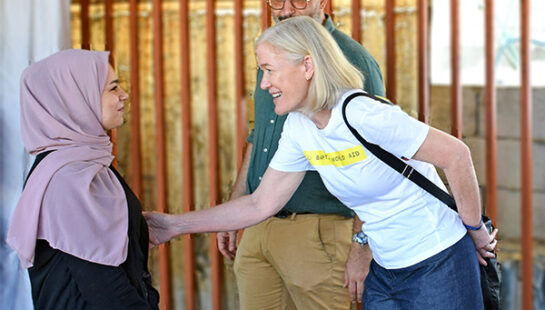The Telling Colour Of The River
In the region of South India that grows most of the cotton for the fashion industry, there is a dark joke: “You can tell what colour will be fashionable in Paris in six months by the colour of our river.”
But the fashion industry is no joke for the local population. And neither are the conditions that young girls are forced to endure in its spinning mills.
The truth is, fashion companies are in fierce competition for our business. And we, as consumers, fuel this competition by demanding cheaper clothes and better bargains. It is a demand which has placed pressure on the companies that supply our clothes to keep delivering the same quality clothing at lower and lower prices.
But if consumers refuse to let companies compromise on quality for the sake of cheaper garments, where, then, do these manufacturers choose to compromise to increase their profit? Sadly, it’s often on fair pay for workers and worker rights. That means longer hours, unsafe conditions, oppressive heat in crowded factories, and fewer benefits for workers… and it also means an increased risk of child-trafficking.
The Sumangali Scheme
The Sumangali Scheme targets young, unmarried girls in poor, rural villages in India. ‘Sumangali’ in Tamil means ‘married woman’. Traffickers show families bright, glossy photos of the buildings their daughters will live and work in. They follow this with fancy sounding promises: a stable income and a lump sum bonus of half a year’s pay after a three year period.
While the custom of dowry was officially outlawed in India in 1961, it has proved more difficult to eliminate in practice. Particularly amongst poorer communities, like the ones targeted by Sumangali Scheme traffickers. A lump sum payment is a tempting offer to a girl in need of a dowry. In this way, families are convinced to send their young daughters, just 13 – 16 years old, off to work in the city . . . where they arrive, in busloads, every few hours.
Meeting Susekula
I met Susekula three weeks ago, when I was traveling in India – part of my work with Tearfund New Zealand to learn more about worker exploitation in the fashion industry.
Susekula arrived to work in the spinning mills with 60 other girls from her village. She was rostered on the night shift until midnight each night… and was up every day at 5am. Working so much forced overtime, Susekula was often sick, and the cotton fibres were always irritating her eyes. Sometimes she only had 10 minutes to sit down for lunch.
When she received her pay checque, Susekula would often discover deductions for ‘offenses’ like returning a minute late from lunch. Deductions were also made for medical expenses, but no medical treatment was ever offered to her.
Listening to Susekula’s story, the reality of worker exploitation hit me in the face.
Vulnerable families are being promised a way out of their poverty, but the reality is that their daughters are being forced to work back-breaking hours in unsafe conditions. Worse still, Sumangali Scheme contracts are frequently terminated just before the promised lump sum payment . . . often leaving girls with nothing but the chronic health problems caused by cotton fibre inhalation.
Fortunately for Susekula, when her contract ended, she met a local organisation that trained her to make her own living. She now works with the same organisation, teaching families to spot the tricks used by Sumangali Scheme traffickers.
‘Because I used to work in the mill myself, I can relate to those girls,’ says Susekula. ‘We train them to use their talents and skills in clothes design and sewing for the local market . . . In this way, they can double their income.’
Because I used to work in the mill myself, I can relate to those girls . . .
It was at once a heart breaking and inspiring story to hear. But what can ordinary people (like you and me) do to help other vulnerable girls like Susekula?
What Can We Do For Exploited Workers?
First, we can stop and feel, even if that’s uncomfortable. When we sit with the world’s pain, we find compassion within us. And compassion gives us the courage and determination to act, rather than to turn away.
Second, when we buy clothes, we can preference the companies doing most to protect workers in their supply chain. This year marks the start of a partnership between Tearfund New Zealand and Baptist World Aid Australia to extend the world-leading research of the Australian Fashion Report to include New Zealand’s favourite fashion brands! The report will launch, under the new title of The Ethical Fashion Report later this month . . . the biggest and best yet!
Finally, we can keep advocating to companies who refuse to make their supply chains transparent. A significant element of transparency is the publication of a list of suppliers. Transparency demonstrates a company’s willingness to be accountable to consumers, the public, and their workers.
Together, with our voices and our ethical choices, we can continue to influence the fashion industry to help protect its workers, and lift people out of poverty.



 Robbie Townsend,
Robbie Townsend,

 Baptist World Aid
Baptist World Aid